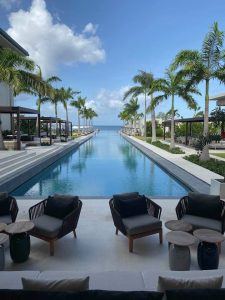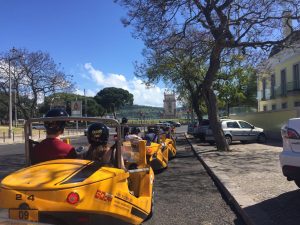Travel its all relative
In the 1930’s most people travelled by train, it was cheap and fast and although during this period commercial airlines started to appear, only the very rich could afford to fly. So if you were the adventurous type and wanted to explore exciting and foreign destinations, how might you go about this? In 1929 relatives of mine embarked on a motor tour from the UK driving through France, Spain, Morocco, Algeria and Tunisia. In the age of package holidays and cheap (by comparison) air travel, who but the very adventurous, would consider such a trip these days?
View Wade Route in a larger map
My relatives kept a travelogue of their journey, which makes fascinating reading, and I was curious to see if any of the hotels mentioned in the journal were still in existence today. The Wade family departed on 19 December 1929 on the overnight ferry from Tilbury to Dunkirk. After a severe overnight frost, cracking ice was heard as the engine was cranked in the morning, but they managed to start the car and drove on to Saint-Germain-en-Laye spending the first night at the Pavillon de Henri IV, one of the best hotels Wade had experienced with wonderful views over Paris! The Hotel still exists today:

This address keeps the memory of the past alive with its carefully restored interiors and 18th century furniture. In the dining room, with its unique & spectacular view over Paris and the Seine valley, a delicious cuisine stamped with modernity, has replaced the noble recipes of bygone days. It is here that in 1897 Collinet invented Bearnaise sauce and the apple souffle!
Continuing down through France with a couple of stops on the way, across the border into Spain and, despite a bad wheel wobble, they arrive in Burgos in the dark after a magnificent run down through avenues of trees in the setting sun. Wade claims this was his ‘finest ever night ride’!
Overnight at the Hotel Norte y Londres, en-suite bathrooms a novelty for the Wades in 1929, but this hotel was founded in 1904 so very modern in its day! The hotel is situated in the heart of Burgos, in the central Plaza de Alonso Martinez, just a short distance from the main tourist spots & cathedral.

Christmas day they were woken by a man in the street blowing a trumpet to alert people to bring out their rubbish! The roads to Madrid were in a bad condition, very bumpy and the sump was grounded. The countryside very barren and things didn’t improve much as they entered the city ‘with all the one way streets, horn blowing and insignificant traffic police blowing whistles’, but they eventually arrive in Madrid and enjoy dinner at the Savoy Hotel for just 12 pesetas!
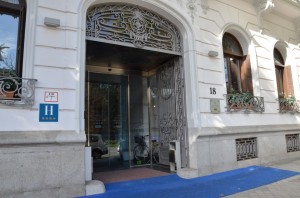
‘the building of the Petit Palace Savoy Alfonso XII was previously a palace dating from the 19th century and is located in Alfonso XII street. The hotel is located opposite the Retiro Park, and is just a few meters from the Puerta de Alcal, the AVE train station of Atocha, the Royal Botanical Gardens’
From Madrid on to Toledo; damage to the luggage rack made re-fueling difficult and again the roads were not good, a wheel puncture necessitated a change to the spare. Whilst Wade changed the tyre his daughter took photos of the villagers doing their laundry. From Toledo they travel to Valdepenas, a muddy village, where they had trouble extracting the car from its overnight accommodation in a pigsty. Road conditions terrible‚ Spain has no consideration for motorists! Hotel Inglaterra‚ breakfast with real English Toast!
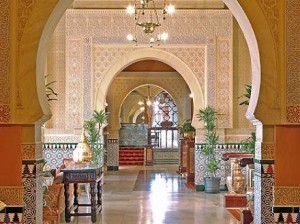
From Seville to Granada and then overnight at the Alhambra Palace Hotel:
‘the views from the terrace bar of the Alhambra Palace, across the city of Granada towards the snow-capped mountains of the Sierra Nevada in the distance, are quite breathtaking. Located just ten minutes‚ walk from the Alhambra and the Generalife Gardens, this is arguably the best first class hotel in Granada: built in the grand Moorish style in 1910, the hotel has recently been renovated, but has retained the original features which include wonderful carved stonework and colourful tiles’
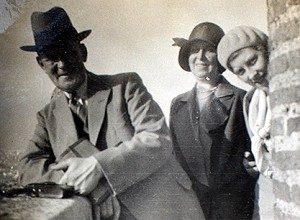
The car gets stuck twice near Antequera. Granada to Gibraltar via Malaga problems going out of and back into Spain the next day and first complaint since leaving England at a British hotel – bed bugs!!
Form Gibralter to Algeciras then Cueta, chosen as it was a shorter sailing time and cheaper fares, but a very rough crossing. Very rudimentary loading procedure with a rope tied to each wheel and a plank of wood wedged between rope and bodywork for protection. All were sick on the crossing, relieved however with nips of brandy. The high winds tear the hood, which is later repaired by needle & thread. Confusion with the documents between the Spanish and French Moroccan Authorities. Road via Tetouan varied from smooth to potholed. Hotels in Tangier not doing well at the time due to the Wall Street Crash, however liners from UK heading for the Med still dropped off passengers for a few days.
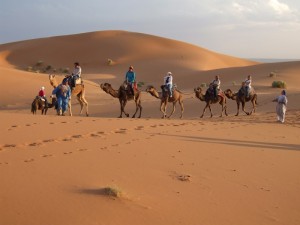
The Romans travelled to Morocco around 150BC, but from the early 1900’s to 1956 it was ruled by Spain & France and those influences can still be seen. Morocco has always inspired British tourists and today is no exception. Casablanca is the largest city and very cosmopolitan, it was immortalised by Humphrey Bogart & Ingrid Bergman in the iconic film named after it. Marrakech lies in the foothills of the snow capped Atlas Mountains and is only a few hours away from the Sahara Desert, the contrasting landscape gives it an enduring appeal. Marrakech has always been a significant trading post in North Africa with it’s maze of colourful market stalls and the largest souk in Morocco. But also find vibrant & exotic gardens and fabulous architecture. Meknes was founded in the 11th century and is situated close to ancient Roman ruins. Whilst in 1930 a touring holiday would consist mainly of site seeing, today you can find plenty of other activities including ballooning, horse riding, trekking and golf.
There was more front wheel wobble on the road from Rabat to Casablanca, adjusted wooden block under one spring, and stay at the Excelsior Hotel, where they had to send out for breakfast marmalade. Fine French shops, Lafayette, in the European quarter gave a good opportunity to shop for sweets, tangerines etc.

The Wades continue their journey from Casablanca, driving through a locust storm, and arrive in Marrakech where they stay at La Mamounia. The best known and probably oldest hotel in Marrakech, La Mamounia re-opened in 2009 after a lavish restoration that has taken over three years. Impressed with the hotel, dinner here was very good too, but no better than a meal at half the price elsewhere! They enjoyed the market place in front of the souk, the snake charmers and monkey trainers, all still unchanged today! After exploring the area with a 20 mile run south to Asni in the foothills of the Atlas mountains, snow capped at this time of year, they retrace their steps back to Rabat and then on to Meknes and Fes staying at the Hotel Majestic and Hotel Transatlantique. After an overtaking accident on the pot holed road between Meknes & Fes the rear wing is repainted.
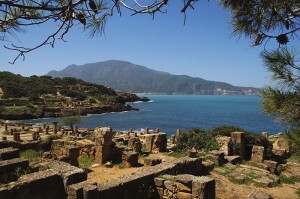
The road conditions are the worst so far, but conditions improved however in Algeria.Driving via Oran to Algiers; taking in the Roman ruins at Cherchell. Wade made enquiries about the road south to the Sahara, crossing from Ghardaia to Touggert. Assistance could apparently be summoned should they get stuck in the dunes! After an overnight stay at the Hotel du Petit Sahara in Bou Saada they travel on to Laghouat via Djelfa, where they have lunch at 3000ft, the coldest place in Algiers.

The Hotel du Petit Sahara mentioned in ‘The Return of Tarzan’ is now known as the Kerdada. In Laghouat they met an English sheep dealer who had a lot of good advice about desert driving, although he had never personally done the bit they were planning! A magnificent sunset was seen from the top of a minaret.
Laghouat‚ Ghardaia, the road so bad that Wade didn’t notice a rear puncture, the tube and cover cut six times, rear tie rod broken and tied to back axle with a piece of string. Later on they had a second puncture using up their 2nd spare; then ran out of petrol 4km short of Ghardaia. Instead of doing 15-20 miles to the gallon they had only done 10 mpg over these slow rough roads. In Ghardaia repairs to the car and punctures had to be arranged, there were no new tyres available in town to suit the Humber, so they had to make do. Wade rang ahead for accommodation the next day at a Foreign Legion Fort at Guerrara and the colonel rooms were reserved. Lady Dorothy Mills, a novelist who wrote of her many travels and explorations, arrived for dinner having travelled from Touggourt. She was apparently researching a book on desert conditions and her driver gave Wade a run down on the sand dunes between here and Touggourt.
Ghardaia‚ Guerrara, one of the repaired punctures found to be flat in the morning so had to be repaired again. 37 km into the journey and there is nothing but desert and not a car has been seen, but three are coming this way tomorrow! Bought five tins of petrol at double the price it was in the north. Dinner consisted of gazelle & kous-kous.

Guerrara ‚ Touggourt, a telegram is sent ahead to request a search party should they not arrive in Touggourt by 4pm. After 62 miles they came to a French Fort where a man came dashing out towards them, having been warned by the French Military they did not allow cars to travel alone, they thought they were in trouble but all he wanted was for them to post a letter for the captain when they reached Touggourt! A further 52 miles, but they had no difficulty until they were within 5 miles of Touggourt, where they encountered sand dunes 30 to 40 ft high and got stuck; they made it into Touggourt with only 10 mins to spare.
Touggourt ‚ Biskra, Palace Hotel, although some loose sand nothing to compare with the previous days driving conditions, back to rocky terrain – the worst was over they were headed back to Europe! They left Biskra after lunch and drove through the Gorge of El Kantara, the gateway to the Sahara when approaching from the north.
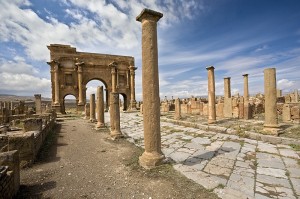
Biskra ‚ Timgad met the first English tourists since leaving England who wanted to know about the conditions in the desert. Visited the Roman ruins at Timgad, supposed to be superior to those at Pompeii; created in 100AD the site remains in excellent condition and in 1982 was added to the Unseco World Heritage list.
Constantine‚ Souk Ahras, the hotel here better than it looked from the outside, hot & cold water in rooms and good food, only problem, toilets! Souk Ahras ‚ Tunisian Border, half an hour to complete formalities at Tunisian border. Special tax on tyres charged according to the weight of each of 6 Dunlop tyres. Visited the Roman ruins at Dougga which has a huge amphitheatre, this site qualified as a World Heritage Site in 1997 by UNESCO as it represents the best preserved Roman small town in North Africa.
Tunis – arrived in Tunis on Sunday and the next sailing to Marseilles is on Tuesday, although the Trans Atlantique offices were closed they established that there was plenty of room. In the meantime they go to view the Roman ruins at ancient Carthage, not as interesting as those at Timgad & Dougga. To the docks to arrange berths and load the car and later get refunded the tyre import duty.
At sea – sailed at 08.05am aboard the SS Duc Dumale at noon arrived at Bizerta for a 4 hour stop. Went ashore but nothing much to see. Once at sea there was some chop and all were more or less sick as usual. Arrive in Marseille and drive up to Vienne and then on to Auxerre where they saw the Monte Carlo rally competitors travelling south. Auxerre to Paris and then Dunkirk. Tilbury to London‚ 3 nights in London then return home on 8 February 1930. The Wades had been away for 49 days in total, had driven 5645 miles and consumed 410 gallons petrol averaging 14 mpg. All six tyres returned intact!
So what are the benefits for the modern traveller relatively speaking, compared to travel form the halcyon days of the 1930’s? I suppose the main difference is how easy it is to obtain information – we can Google destinations, we can look at ‘Trip Advisor’ and read real reviews, we can read blog posts from people who have travelled to the places we want to see; but maybe we have lost something more important and that is innocence – that sense of the unknown, that sense of adventure of departing for a foreign land and not knowing what might happen and that sense of wonder. We are in a very different age of travel now and our expectations and the limitations of our travel choices are fuelled by the media and that is not necessarily a good thing! Travel its all relative!
With special thanks to Paul Hargreaves for extracts from the ‘Family History’!





